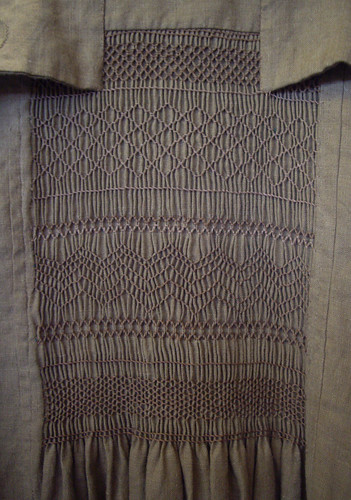On Sunday afternoon I persuaded Paul to wander round the Museum of English Rural Life.
I hadn’t been since it moved location (in 2005!), and it’s in a much bigger space now. It’s a slightly strange museum – laid out more like a store room than an exhibit, with things shoved up corners and hanging from the ceiling – but it’s an amazing collection, and there’s a wealth of information to go with it.
The highlight of my trip was getting to play dress-up with the reproduction linen smocks. They didn’t have a pair of farmer’s clogs in my size, otherwise I’d have been wearing those as well!
(I used to wear slip-on clogs all the time when I was a student. My friends kindly referred to them as “those sawn-off wellies”. Charming.)
The highlight of the trip was tagging on to the tail end of a guided tour, and being allowed upstairs into the archives – and they have MASSES of textiles! Lace fans, embroidery samplers, tatting, and LOADS of clothing.
I’ve taken a large number of photos of the reproduction smocked coat and tunic, although I was so over-excited that I completely forgot to take pictures of the inside. These garments would have been made entirely by hand, so I’d like to have a look at how the seams were finished.
I can’t help wondering whether there’s been an extensive study made of all the garments hidden away in the archives. With the exceptions of craft books and sampler patterns, I can’t find anything that’s been published on the subject in more than twenty years. (A study was done in 2001, but it’s out of print.)
The next time I go over to the University library, I might have to browse around the clothing and folklore sections, and see what I can find out. This smock collection is crying out “PhD” to me. I wonder…


Hi Claire,
I am very glad to hear you enjoyed your visit to MERL. The current displays were indeed designed with ‘open storage’ in mind but I am pleased you also felt that there was sufficient information and material on display. I am also pleased that you had the opportunity to visit our reserve collection store as part of a guided tour.
Besides the replicas on display (that you were able to try on), the MERL smock collections include some fifty four individual artefacts, which entered the collections mostly between 1951 and 1968, with only a handful postdating this. They are largely believed to date from the final decades of the nineteenth century and are, with a few exceptions, thought to have been worn during the working life of their original owners and/or in later theatrical contexts. You are right to point out that these are extremely important collections. As such, the museum conservator has recently undertaken to improve storage conditions for our entire costume holdings. We also have a couple of projects on the horizon that centre around these artefacts.
With the assistance of a student bursary, paid for by the Arts Committee of the University of Reading, this summer we plan to consolidate all the documentation and information we hold on these items, such that it can be made available online. This will involve extensive photography, further condition checking and conservation improvements, and examination and digitization of our collections-related archival materials.
Subject to obtaining funding to do so, we also hope to complete a display case of costume materials to augment our current exhibitions and complement the ‘dress-up’ replicas. These displays would draw upon materials in our reserve collections, some of which you will have seen during the tour.
In the meantime, if you are interested in pursuing further research into these materials then I suggest you pay a visit to the MERL library (on the same site as the Museum but open weekdays only) rather than the main University library. The MERL library has a far more extensive range of literature on this subject and would be a good jumping-off point for research into these (and other) rural/agricultural object collections. You could also take a look at this slightly outdated section of the MERL website – http://www.reading.ac.uk/merl/the_collections/the_museum/smocks.html – which provides a summary of the smock holdings.
I couldn’t tell you offhand if anyone has undertaken doctoral research into these collections but we would be delighted to provide further research access were you keen to take your interest further. If you are interested in acquiring further information please use the main MERL enquiry email (on the website). The enquiry will most likely be directed to me and I will be able to forward to you a general costume-related bibliography, whcih may contain literature to answer some of your more detailed questions.
Many thanks for your positive feedback and ongoing interest.
Ollie Douglas